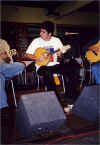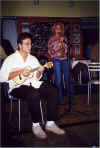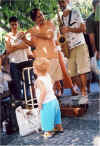Brazilian Popular Music
The Roots of Brazilian Music - Part II - From the eighteenth century "música de barbeiros" (barber music) to the choro.
Choro - A Brazilian classic!
Anyone who studies Portuguese will sooner or later come across the word
"choro," which means "weeping" or "crying." But how many
people out there know that "choro" is also a musical form? (Actually, some
experts say that the name is meant to suggest the impression of melancholy of certain
guitar modulations.) To read more about the origins of choro -- if you
read Portuguese -- we recommend you get yourself a copy of Henrique Cazes'
Choro: Do Quintal ao Municipal. Dirty
Linen has a thorough examination of the genre online. Check out our Choro
page for CD suggestions.
Primarily instrumental, characterized in part by improvisation and virtuosity, with one
or more soloists, it originated in Rio de Janeiro in the 1870's. It was initially a
Brazilian way of playing European dance music, waltzes, polkas, etc. Traditional
instrumental groups consisting of two guitars and cavaquinho - called "música de
barbeiros", because the slaves who played in them were also trained as barbers - had
existed since the middle of the 18th century. To those were later added the flute,
clarinet and bandolim.
 |
 |
| Bruno Rian, bandolim |
Déo Rian and Dino 7 Cordas |
Hundreds of choro groups (called "chorões") would spend the night playing
for food and drink, in private homes or botequins (described by someone as Rio's answer to
the French bistro). The young Villa-Lobos
- having a very strict father - used to escape through the window to join these musicians
in the streets of Rio... He would later compose a series of 14 Choros and call the form
"the essence of the Brazilian musical soul."
The first generation of chorões includes the flutists and composers Joaquim Antonio da
Silva Calado Júnior - author of the beautiful "Flor Amorosa" (Amorous Flower) -
and Viriato Figueira da Silva. The pianist Chiquinha Gonzaga (1847-1935), the greatest
female composer of Brazilian popular music, wrote several choros ("Atraente",
"Corta-Jaca") which are still included in the chorões repertory. To celebrate
the 150th anniversary of Chiquinha's birth, pianist Antonio Adolfo released a
"jazzy" CD of her compositions called Chiquinha com Jazz.
Ernesto Nazareth
(1863-1934) left more than 220 compositions, including the classics "Apanhei-te
Cavaquinho" and "Odeon" (named after the cinema where he played the piano).
Villa-Lobos at the time was a cellist in the orchestra at the Odeon and was apparently
influenced by Nazareth's improvisational style. Other famous composers of this time are
Zequinha de Abreu, author of "Tico-Tico no Fubá" (remember Carmen Miranda
singing this song in the film Copacabana?), and João Pernambuco who wrote
"Brasileirinho."
Who is considered the greatest choro musician of all time? Perhaps the
flutist and saxophonist Pixinguinha (1897-1973), born Alfredo da Rocha Viana Júnior. He
is also the composer of the unforgettable "Carinhoso" and other masterpieces -
Ingênuo, Lamentos, Um a Zero (1 x 0), etc. Pixinguinha and his group "Os Oito
Batutas" were the first to incorporate percussion instruments to choro and the
pandeiro (Brazilian tambourine) is still the rhythm base in traditional choro.
 |
 |
| Rabo de Lagartixa |
Daniela Spielmann |
 |
 |
| Eliane Salek, flauta |
Jorginho do Pandeiro |
Chorões of a later generation (1940's) are the bandolim virtuoso Jacob
do Bandolim, author of "Noites Cariocas" and leader of the famous
"Época de Ouro" (Golden Era), flutists Benedito Lacerda and Altamiro Carrilho,
saxophonist Abel Ferreira and the great master of cavaquinho, Valdir Azevedo.
 |
 |
 |
| Dino and Cesar Faria |
Daniela Spielmann, saxophone |
Época de Ouro |
The late 60's and the 70's saw a revival of the choro - expanding from the jam sessions
at the popular Sovaco de Cobra botequim in the suburb of Penha in Rio - with a new
generation of musicians and composers: Paulinho da Viola, Déo Rian (who led the group
Época de Ouro after Jacob do Bandolim died in 1969), Joel do Nascimento, Paulo Moura - even
though he started much earlier, this is when he became really famous - and Henrique Cazes
belong to this time. In 1987 and 1988 some of these chorões, along with old master
Altamiro Carrilho, recreated the choro "rodas" or jam sessions from suburban Rio
on the stage of its Municipal Theater. The resulting CD, appropriately called "Noites
Cariocas" (Rio Nights) is a beautiful introduction to this fascinating musical genre.
 In April of 1997, Brazil celebrated the 100th anniversary of Pixinguinha's birth. We're
happy to report that choro is booming again, with a new generation of musicians
and
legions of fans of all ages. Places to listen to choros in Rio (like
this "chorinho na feira" at a street market in Laranjeiras every
Saturday...you can buy your fruits and vegetables and listen to a great,
free concert...where else in the world?) are
listed in our Little Black Book. In
Brasília, don't miss the Clube
do Choro and the Escola de Choro Raphael Rabello! Women musicians aren't as numerous as guys, but female choro practitioners of all ages are heard at rodas de choro everywhere; some are pictured here: Eliane Salek (flute), Daniela Spielmann (saxophones), and Luciana Rabello (cavaquinho). Another well-known flutist is Odette Ernest Dias; Nilze Carvalho (from the group Sururu na Roda) is a singer and cavaquinho player; Mariana Bernardes and Ana Rabello play cavaquinho; and Sheila Zagury and Maria Teresa Madeira are celebrated pianists.
In April of 1997, Brazil celebrated the 100th anniversary of Pixinguinha's birth. We're
happy to report that choro is booming again, with a new generation of musicians
and
legions of fans of all ages. Places to listen to choros in Rio (like
this "chorinho na feira" at a street market in Laranjeiras every
Saturday...you can buy your fruits and vegetables and listen to a great,
free concert...where else in the world?) are
listed in our Little Black Book. In
Brasília, don't miss the Clube
do Choro and the Escola de Choro Raphael Rabello! Women musicians aren't as numerous as guys, but female choro practitioners of all ages are heard at rodas de choro everywhere; some are pictured here: Eliane Salek (flute), Daniela Spielmann (saxophones), and Luciana Rabello (cavaquinho). Another well-known flutist is Odette Ernest Dias; Nilze Carvalho (from the group Sururu na Roda) is a singer and cavaquinho player; Mariana Bernardes and Ana Rabello play cavaquinho; and Sheila Zagury and Maria Teresa Madeira are celebrated pianists.
 |
 |
 |
| Cavaquinho and bandolim |
Choro at Cobal |
Two cavaquinhos |
 If you find yourself spending more time in Rio, you may want
to consider taking classes from masters Luciana Rabello, Mauricio Carrilho,
and others, at their Escola Portátil de Música, every Saturday from 9 a.m.
to 5 p.m. at Unirio (Urca). We witnessed some 120 musicians of both sexes,
all ages and races, playing together under three huge mango trees, during
their lunch break (noon)...It was one of the most beautiful sights of my
entire life!
If you find yourself spending more time in Rio, you may want
to consider taking classes from masters Luciana Rabello, Mauricio Carrilho,
and others, at their Escola Portátil de Música, every Saturday from 9 a.m.
to 5 p.m. at Unirio (Urca). We witnessed some 120 musicians of both sexes,
all ages and races, playing together under three huge mango trees, during
their lunch break (noon)...It was one of the most beautiful sights of my
entire life!
 |
 |
| Dino and Ronaldo do Bandolim |
Alessandro, cavaquinho |
Every year on April 23rd, Dia Nacional do Choro, there are shows and
celebrations all over Brazil...especially in Rio; it's a great time to
visit the city!
To find out more about choro and see some of these wonderful musicians perform, get yourself a copy of the DVD The Sound of Rio: Brasileirinho, available from Milan Records. There's also an excellent article about choro online at Dirty Linen magazine.
This page continues on Music Roots 3 - A Brief History of Carnaval
and Its Music
One way to keep up with what's going on is at Agenda
do Samba e Choro (in Portuguese).
Music & Folklore
















